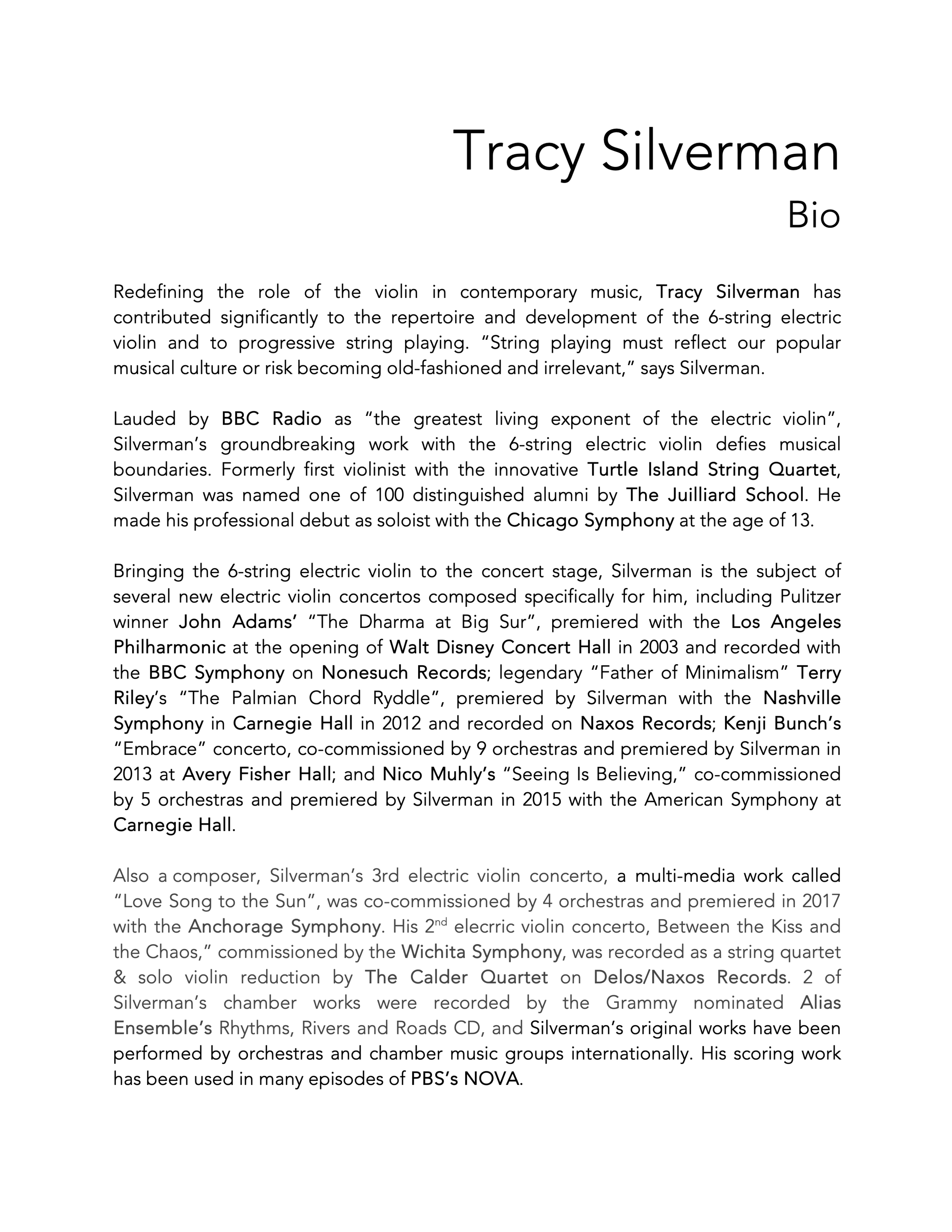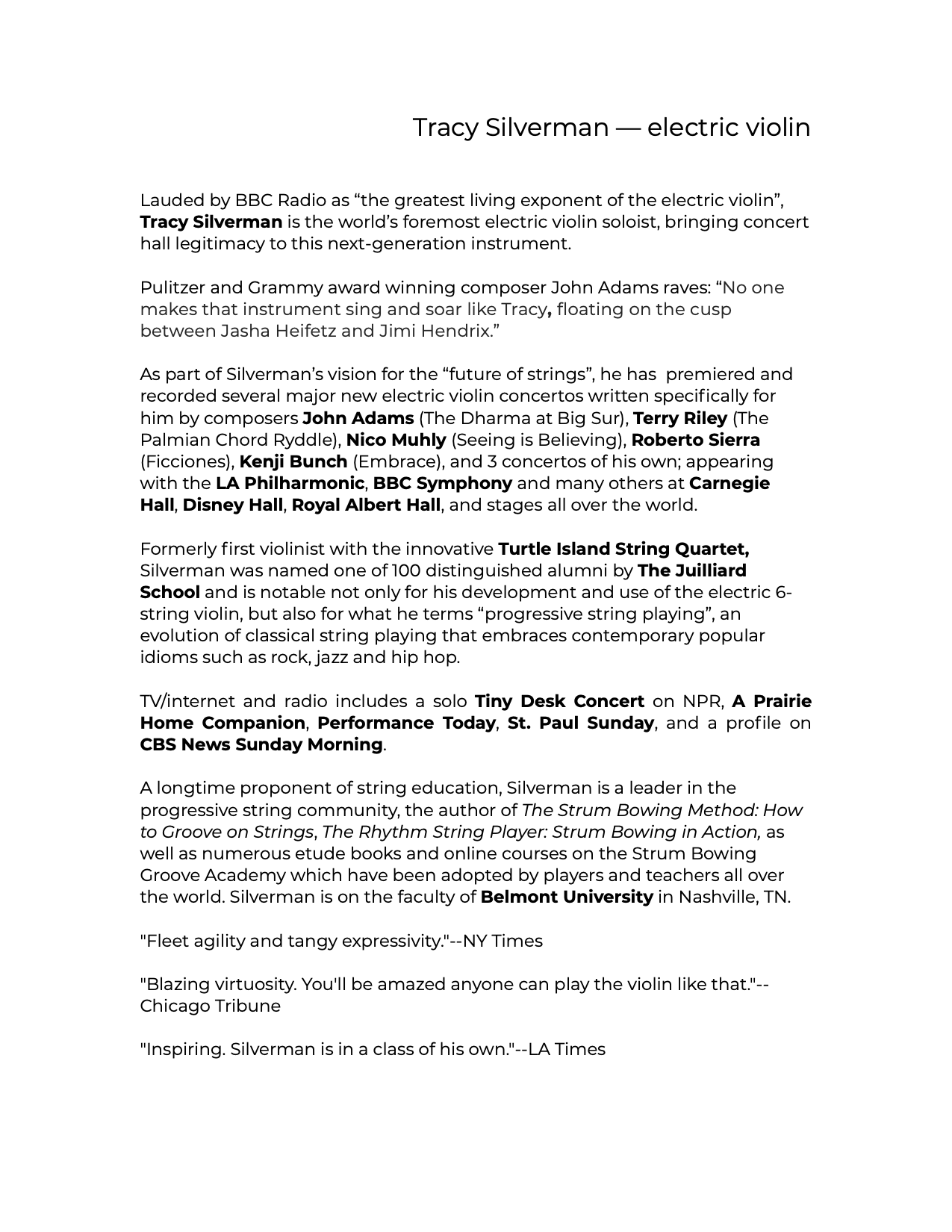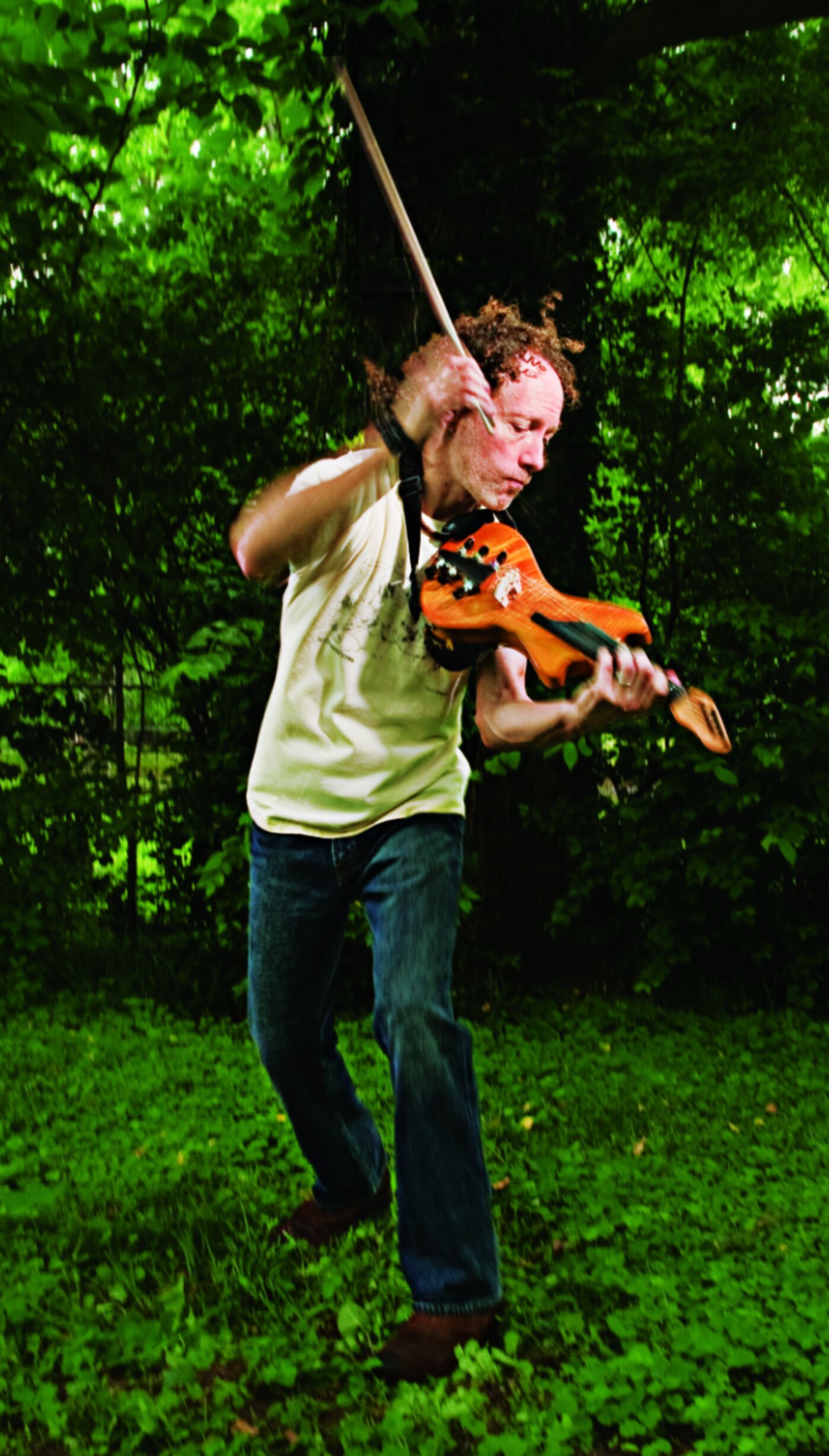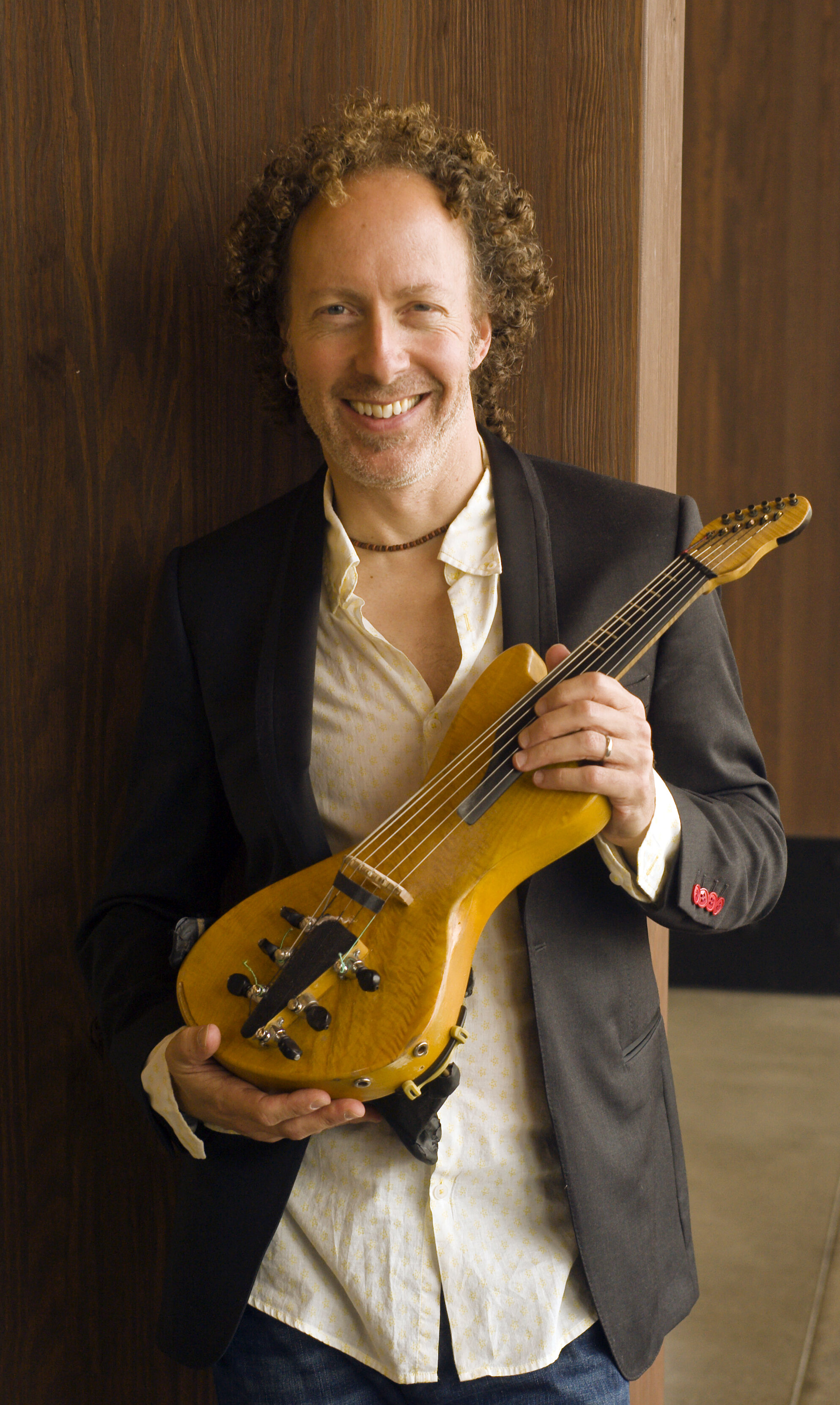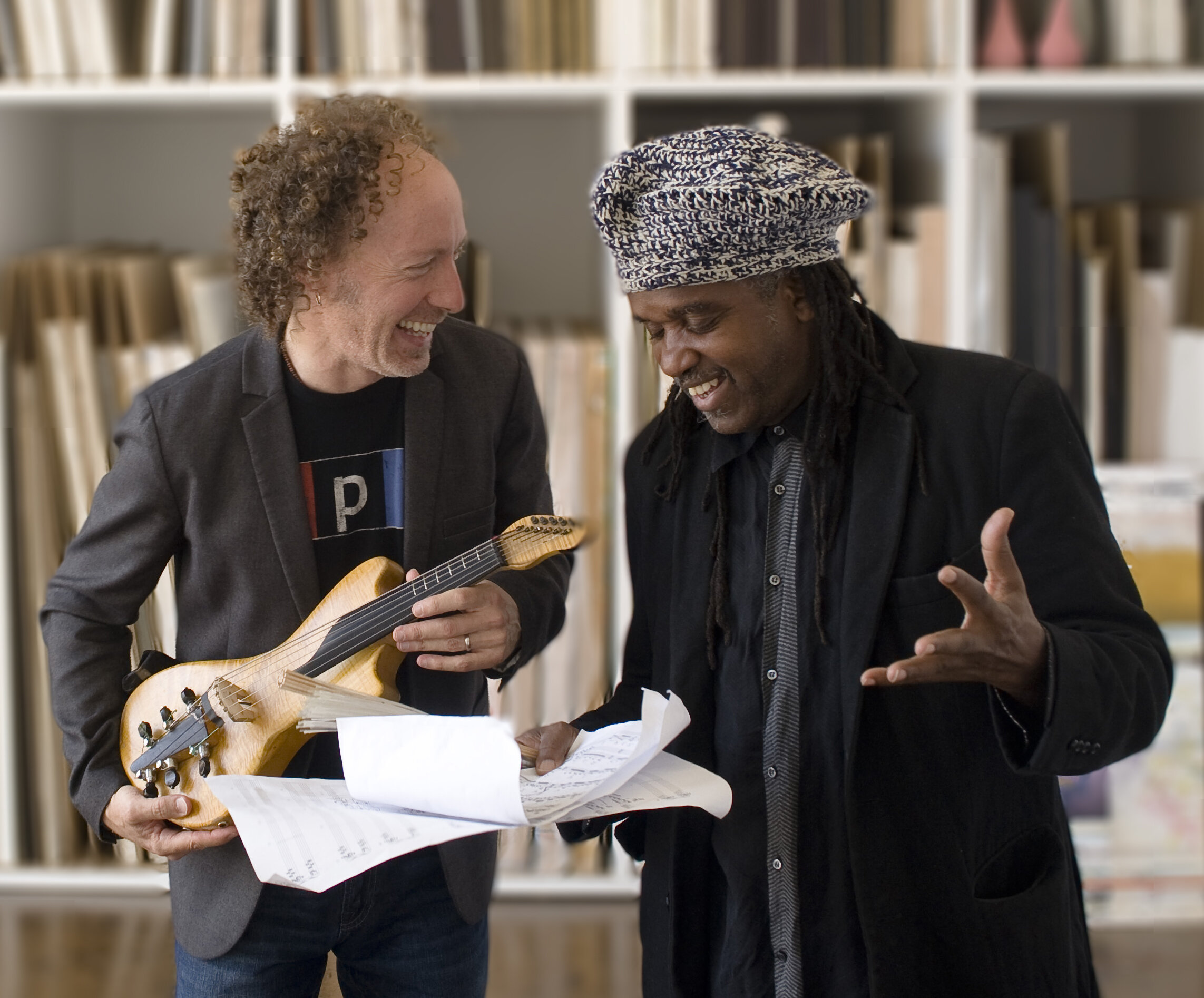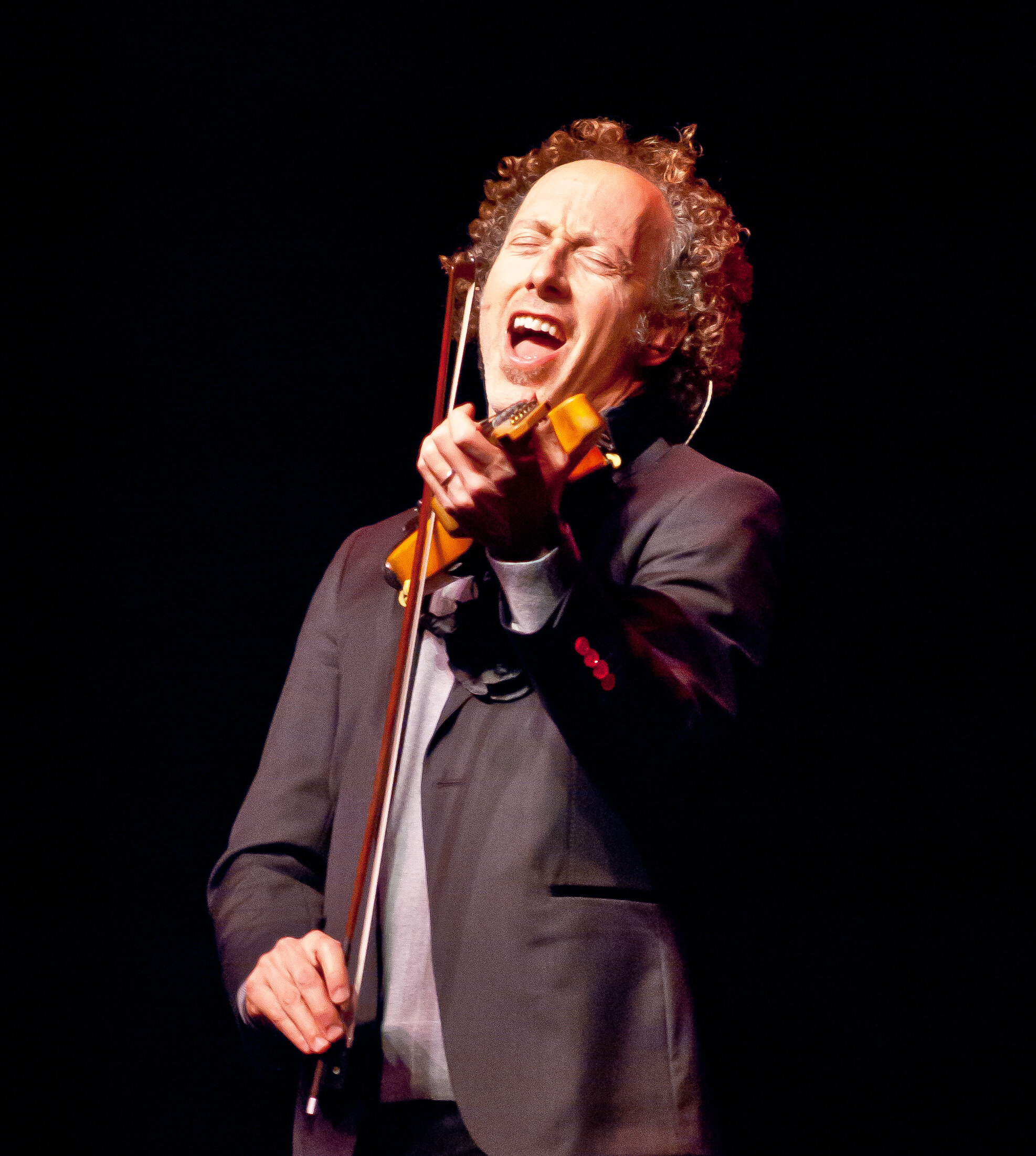Calendar
-
-
with visual artist María Magdalena Campos-Pons
-
with visual artist María Magdalena Campos-Pons
-
with visual artist María Magdalena Campos-Pons
-
with visual artist María Magdalena Campos-Pons
-
with visual artist María Magdalena Campos-Pons
-
with visual artist María Magdalena Campos-Pons
Tracy Silverman is one of the world’s foremost electric violin soloists, bringing concert hall legitimacy to this next-generation instrument. As part of Silverman’s vision for the “future of strings”, he has premiered and recorded several major new electric violin concertos written specifically for him by composers John Adams (The Dharma at Big Sur), Terry Riley (The Palmian Chord Ryddle), Nico Muhly (Seeing is Believing), Roberto Sierra (Ficciones), Kenji Bunch (Embrace), and 3 concertos of his own; appearing with the LA Philharmonic, BBC Symphony and many others at Carnegie Hall, Disney Hall, Royal Albert Hall, and stages all over the world.
Formerly first violinist with the innovative Turtle Island String Quartet, Silverman made his professional debut at the age of 13 as soloist with the Chicago Symphony Orchestra and was named one of 100 distinguished alumni by The Juilliard School. Silverman is notable not only for his development and use of the electric 6-string violin, but also for what he terms “progressive string playing”, an evolution of classical string playing that embraces contemporary popular idioms such as rock, jazz and hip hop.
TV/internet and radio includes a solo Tiny Desk Concert on NPR, A Prairie Home Companion, Performance Today, St. Paul Sunday, and a profile on CBS News Sunday Morning. A longtime proponent of string education, Silverman is a leader in the progressive string community and the host of The Greater Groove: The Future of Strings podcast. His Strum Bowing method has been adopted by players and teachers all over the world. Silverman is the author of The Strum Bowing Method: How to Groove on Strings, and The Rhythm String Player: Strum Bowing in Action, as well as several etude books and online courses on his Strum Bowing Groove Academy. Silverman is on the faculty of Belmont University in Nashville, TN.
"Fleet agility and tangy expressivity."--NY Times
"Blazing virtuosity. You'll be amazed anyone can play the violin like that."--Chicago Tribune
"Inspiring. Silverman is in a class of his own."--LA Times
• BACK TO TOP •
Contact
OTHER INQUIRIES
info@tracysilverman.com
MANAGEMENT & BOOKING
USA:
Brian Horner
Craft Brewed Music
(615) 364-7656
bhorner@craftbrewedmusic.com
www.craftbrewedmusic.com
• BACK TO TOP •
Press Quotes
“The greatest living exponent of the electric violin.”
—BBC Radio
“I first heard Tracy Silverman at an Oakland, CA jazz club and immediately I wanted to write a piece for him. “Dharma at Big Sur” was the result. No one makes that instrument sing and soar like Tracy, floating on the cusp between Heifetz and Jimi Hendrix.” —John Adams, Pulitzer Prize winning composer
“Inspiring. Silverman is in a class of his own”
—Mark Swed, LA TImes
“Fleet agility and tangy expressivity with wailing hints of Jimi Hendrix.”
—Anthony Tommasini, New York Times
“Tracy Silverman’s six-string instrument wails and coos with considerable subtlety in this very desirable recording.” --Bernard Holland, New York Times
“Silverman tackles the work’s impetuous demands with a winning balance of precision and spontaneity: Riley’s rhapsodic, portamento-heavy solo lines, achingly lyrical at times, sound sometimes like prog-rock guitar solos on Silverman’s multi-octave, six-stringed instrument, but he delivers each with ringing clarity and sonic purity. He also brilliantly captures the concerto’s sense of in-the-moment creation, of semi-improvised ideas that only slowly coalesce, in playing that’s both committed and perceptive.” —David Kettle, The Strad Magazine
“Vibrant playing”
—Steve Smith, New York Times
“What informs almost every bar of the work is the blazing virtuosity of Tracy Silverman, playing a six-string electric violin. Listen to Silverman flinging seagull-like spirals and caws over Adams’ big and busy symphonic apparatus in the ecstatic finale and you will be astonished that anybody can play the fiddle like that.”
—John von Rhein, Chicago Tribune
“Jimi Hendrix would have been proud. —David Wright, New York Classical Review
“Tracy Silverman played as if he believed in every note and there was a whooping standing ovation.”
—Scott Cantrell, Dallas Morning News
“Electric violinist Tracy Silverman could become classical music’s newest rock star.”
—The Nashville Scene
"...a master of the six-stringed electric violin's technical possibilities; he can shred like a rock guitarist in front of an orchestra." —Financial Times
“Tracy’s violin is like an orchestra in and of itself. His sound has an unmistakable personal warmth that can move a listener to states of deep emotion and he spontaneously unearths melodic ideas of great subtlety. Tracy has a unique arsenal of sounds and effects that manifest anything from orchestral textures to grungy biting sound clouds and he knows when and where to use them.”
— composer Terry Riley
”Tracy has developed his own unique style of violin playing–a marvel of expressiveness, the product of his having digested everything from Stefan Grapelli to the Indian saranghi to bluegrass, Robert Johnson, and Terry Riley. Hearing Tracy Silverman play his six-string electric violin immediately reminded me not only of the great jazz and rock performers and Pakistani qawwalisingers like Nusrat Fateh Ali Khan (where the real music is in the slide between the notes), but it also made me think of the prose style of Jack Kerouac, so deeply influenced by his listening to the rhythms and melodic arcs of improvised jazz.”
—Pulitzer Prize and Grammy Award winning composer John Adams
“An amazing virtuoso. In many ways, Silverman is the quintessential Nashville musician: a creative and technically accomplished performer, who can command all styles of music from rock to classical to jazz.”
—Giancarlo Guerrero, conductor Nashville Symphony
“A terrific, charismatic musician.” –George Grella, New York Classical Review
“Tracy Silverman’s electric violin playing touches on everything I love about not just the violin but sound itself”
—Ari Messer, San Francisco Bay Guardian
“With his six-stringed instrument Silverman brandishes notes with bravado.”
—The Tennessean
“I could find no fault with Silverman’s performance. Throughout his rendition, the Nashville virtuoso was intensely in the moment, playing with a commanding technique and deep emotion.”
—John Pitcher, The Nashville Scene
“Silverman’s violin sound is gorgeous and allows for a wider range of expression and power than an acoustic violin, and he was an exciting interpreter for the new work, with moments of deep emotion.”
—Sequenza 21
“A cool character.”
—National Public Radio
“Silverman seemed totally at one with the music and effectively managed to preserve a sense of spontaneity suggestive of improvisation in his virtuosic performance.”
—Stephen Whittington, The Advertiser, Adelaide, Australia
“The Dharma at Big Sur serves as a breathtaking showcase for Silverman’s dazzling instrumental prowess. A transcendent performance that casts aside traditional notions of what classical music should sound like.”
—Jonathan Marx, The Tennessean
“Adams’ electric violin concerto, The Dharma at Big Sur, was inspired by several elements, but the primary motivation was Tracy Silverman, the Juilliard-trained jazz violinist for whom the work was written. Silverman was the soloist Saturday with his six-stringed electric fiddle, and with Adams on the podium the performance kicked up a truly combustible collaboration. Silverman’s hypnotic concentration and range of color in his extended solo phrases were remarkable, suggesting raga-like wails, febrile Mosque prayers, ancient chant, even the unearthly sound of a Chinese erhu. The inexorable crescendo to the final coda was thrilling, with Silverman, Adams and the orchestra striking sparks in a quite sensational performance.”
—Lawrence Johnson, Miami Herald
“Using an interesting stylistic mix of Indian raga singing and stabbing, portamento-rich blues, the solo part dances and sails over a slowly building harmonic platform in the orchestra to reach an ecstatic high at the work’s climax. Playing a six-string electric violin with a liberating raw energy, Tracy Silverman captured exactly the effect Adams asks for: unstructured spontaneity and the transcendent awe felt at witnessing, close-up, nature’s elemental forces.”
—Graham Strahle, The Australian
“Inspired by the playing of jazz-rock-World Music fusion artist Tracy Silverman, Adams has created his most adventurous score yet. Tracy Silverman is a true virtuoso of the six string electric violin. Producing a gutsy, hard edged sound, he whirled through the concerto’ s bravura episodes and offered contrasting floods of serenity as the violin rose ever higher over the orchestral kaleidoscope.”
—Lawrence Budmen, South Florida Sun-Sentinel
“Above all, a new solo language, forged expressly for the classically trained jazz electric violinist Tracy Silverman. His deep engagement with the Asian-influenced music coursed through his strong, supple virtuosity.”
—Hilary Finch, The Times, (London) Tuesday, August 24, 2004
“A showcase for the startling virtuosity of jazz electric violinist Tracy Silverman.”
—Andrew Clements, The Guardian, (London) Tuesday, August 24, 2004
“Charismatic”
—Stephen Pettitt, The Evening Standard, (London) Monday, August 23, 2004
“Dharma is a concerto for electric violin. That violin, as Tracy Silverman miraculously plays it, evokes Jimi Hendrix’s wailing electric guitar and Ravi Shankar’s astral sitar when it is not suggesting a mellow cello or even a plain old violin. And Silverman, in an inspiring display of dharmic duty, has astonishingly memorized difficult music. Every detail is notated. But his performance Thursday, during which he wandered around the stage, even executing a few slow whirling dervish twirls while playing, sounded free (if anything but easy) and improvised.”
—Mark Swed, LA Times, May 27, 2005
“Silverman plays it with the conviction born of a true understanding of the composer’s intentions.”
—Holly Harris, Winnipeg Free Press , Dec 4, 2006
“A winsome fellow with Kenny G curls and an endearingly blissed-out air, soloist Tracy Silverman drew from his souped-up fiddle ecstatic shrieks, soulful growls, and swoops and slides of phosphorescent radiance.”
—Marion Lignana Rosenberg, Newsday, June 8, 2005
“Silverman walks around the stage, breaking the box classical cats stand in. Finally he reaches up way high and we get a big moment. Silverman turns a circle. The music gets louder and louder. The violin rushes to the stratosphere. We get arpeggios and flying fingers. We’ve taken off. Adams turns on the electricity and lets Silverman blow above the orchestra playing full blast. With a rush and a flourish it’s over. The audience loves it. So do I. It’s his best piece in years.”
—David Salvage Sequenza21, June 6, 2005
“Adams wrote the 40-minute piece for a veteran of Riley’s ensemble, electric violinist Tracy Silverman, who proved to be an ideal exponent of its raga-inflected arabesques. With his long, curly mane and embroidered maroon shirt, Silverman’s look matched the music, as did his body language — he spun around in circles during one swirling passage. His solo part was like endless aria, trailing off only to build up again; his searing slurs and bends were deeply expressive.”
—Bradley Bambarger, NJ Star-Ledger, June 7, 2005
“Silverman is a remarkable performer, skillfully building the excitement of the piece, written especially for his six-string electric instrument. He wears it strapped around neck and shoulders, coaxing from it all sorts of sliding, moaning, plangent tones. Several years ago, Adams saw Silverman perform at Yoshi’s, the Oakland jazz club, and decided to write the new work for him. Silverman, a former prodigy and a Juilliard graduate, had stepped outside the “controlled realm” of Western classical music, Adams said Saturday, and looked to other sources: Indian ragas, Hendrix, jazz. In writing “Dharma,” Adams explained to the audience, he hoped to evoke the spirit of the Beats, particularly of Jack Kerouac in his novel “Big Sur.” He saw Silverman as a Kerouac stand-in, an opener of the “revelatory moment.”
—Richard Scheinin, San Jose Mercury News, Aug 16, 2004
“Tracy Silverman wove an endless freewheeling melody that at times resembled a Jimi Hendrix solo.”
—Alex Ross, The New Yorker Magazine
“The work’s soloist and muse is violinist Tracy Silverman, whose improvisatory classical-jazz fusion, played on an electric six-string instrument of his own devising, piqued Adams’ interest. It’s easy to see why; the sounds he produces, with their bent notes and sinuous phrases, are both piercing and poignant.”
—Joshua Kosman, San Francisco Chronicle
“‘The Dharma at Big Sur’ was also shaped by Adams’ hearing classically trained violinist Tracy Silverman at an Oakland jazz club and writing the violin part with Silverman’s “Kerouacian spirit” in mind. He called the result, which Silverman will be playing at Disney Hall tonight, “the closest thing to a genuine collaboration I’ve ever done with a performer.”
—Scott Timberg, LA Times
“The star turn of the evening was John Adams’s new “The Dharma at Big Sur,” a heartbreakingly beautiful work for electric fiddler (Tracy Silverman) and full orchestra, in which high, piercing folk sounds from East and West were wrapped in the richness of the classic symphonic tradition by a composer who understands and loves them all.
—David Littlejohn, The Wall Street Journal
“It is full of surprises, the biggest being that it is a violin concerto, written for an unconventional electric violinist, Tracy Silverman, who happens to be in a class of his own. Taking the evening’s recommended dress code — L.A. chic — to an entirely unexpected level, he appeared in a flowing blue shirt and brown pants patterned with large squares on the sides. His long curly hair was set off by a tiny strip of beard on his chin. Silverman’s approach is as different from the classical model as is his look. Standing in front of a large loudspeaker, he produced an amplified fiddle sound that was excitingly raw and raucously toned. Electronics gave him a wide range, from cello to violin. The effect was that of an arresting whine, a cross between rock guitarist Eric Clapton and Indian sitarist Ravi Shankar. For nearly half an hour, over the two insinuating movements of this piece, he was in constant melodic flow. At first the sound of this raspy violin comes as a shock over these orchestral pastels. The tuning is also unconventional, following the lead of Lou Harrison with musical intervals purer than the traditional style — and much harder to control. The shock very quickly turns into delight as it dawns on a listener that this melodic invention, the feeling of controlled (but just) ecstasy, might actually go on for a wonderfully long time.”
—Mark Swed, LA Times
“Beneath its oh-so-California title, the Adams work also is a concerto, this one tailored to the special talents of Tracy Silverman, he of the wild curls and even wilder electric violin. Silverman soared and scraped up a storm of bent-pitch arabesques over a huge orchestra that included two keyboard samplers, prerecorded tape and computer-controlled sound system.”
—John von Rhein, Chicago Tribune
“Tracy Silverman, the soloist who belongs among the inspirers, plays a six-string electronic violin into a microphone and into processing circuitry; it gives him the remarkable ability to carry a lyric line all the way from the highest notes of a normal violin down into cello territory. ‘I planned Dharma as a piece about ambiance,’ says Adams, ‘and then in addition it became a violin concerto. That happened when I discovered the phenomenal Tracy Silverman, who will play the solo part on his six-string electric violin.'”
—Alan Rich, LA Weekly
“Silverman gave and assured and comfortable reading.”
—Timothy Mangan, Orange County Register
“Groovy electric violin soloist Tracy Silverman played just-intonated music that sounded like Music of the Spheres.” –Pierre Ruhe, The Atlanta Journal-Constitution“A surprisingly virtuoso electric-violin solo by Tracy Silverman that rose in obbligato over the sustained orchestral chords.”
—Melinda Bargeen, Seattle Times
“As soloist on an electronically adapted, six-string violin, Tracy Silverman produced a seemingly endless, rhapsodic thread of melody, his instrument spanning the range from deepest cello to ecstatic violin.”
—Alan Rich, Variety
“‘Trip to the Sun’ may be the most adventurous Windham Hill album ever. He duets with minimalist pioneer Terry Riley on two spiraling improvisations for muted piano and viola, and he turns Jimi Hendrix’s “1983…(A Merman I Should Turn To Be)” into a dreamy chamber-dub soundscape. Silverman also creates several overdubbed solos that avoid the cliches of the genre. “Improvisation with Overdubs” is a meditative-yet-searing work, while “Fugue En Groove” is a nice piece of baroque electronica.”
—John Diliburto, Billboard
“Silverman is stretching out in yet another direction, in a harder rock direction, with stops in classical, jazz and electronica”
—Philadelphia Inquirer
“Silverman is a fine, expressive player.” —London Guardian“…towards the end of the evening, Silverman showed that he can do more than just play brilliant violin. With his powerful voice he sang “Little Wing” by Jimi Hendrix. When you have experienced the pyrotechnics of sound, when you have seen it, with all the ways and means of tone that can be unlocked from his various violins, when you can feel the joie de vivre and pleasure which lies in both the electric and acoustic pieces, then you can, spurred on by the calls for “encore, encore” say, “More courage to new forms of music!”
—Main Echo
“…technically brilliant to the fingertips, but overthrowing all the usual preconcieved ideas…a star-studded hour in it’s own right.”
—Rhein-Neckar Zeitung
“…his violin luminated in rainbow colors and hung easily across the shoulders. First there is some hand-clapping fun with the audience, then the young star from America grabs forcefully into the strings and the electric fiddle mutates easily into a rock guitar. Like Jon Bon Jovi, Silverman has soothing ballads, as in his version of George Gershwin’s “But Not For Me”, that would easily fit on a rock CD. Music, for Tracy Silverman, is a wide field indeed.”
—Nurnburger Zeitung
“…Tracy Silverman honors Jimi Hendrix by citing Jimi’s classic “Purple Haze” with a flattering cadenza on his violin.”
—Frankfurter Rundschau
“…Silverman created the whole of the performance by reorganizing sections of songs. The phenomenal violinist has worked with Leonard Bernstein, Terry Riley, Billy Taylor and Michael Bolton among others. All these different influences had a very productive effect on his music. It breaks out of the usual structures and catagories.”
—Weser Kurier
“…Miracle-violinist Tracy Silverman restrained himself nobly until he played the Hendrix homage, “Little Wing”, and it almost seemed as if he had exchanged his violin for a guitar.”
—Suddeutsche Zeitung
“…And when there is such a good musical foundation carrying such connoiseurship for making music, the difficulty of changing between acoustic and electric music dissappears…It was music straight from life, full of energie, charm and wit.”
—Main Echo
“…Silverman’s true musical home was displayed in his rather rock-influenced interpretations of the Gershwin tunes, “Embraceable You” and “But Not For Me”, playing violin and also singing on both songs, especially in the 2nd of these, in which Silverman soloed with the helpful use of loop technology, and which compares closely with the lyrical feeling of a metal ballad.”
—Main Post









